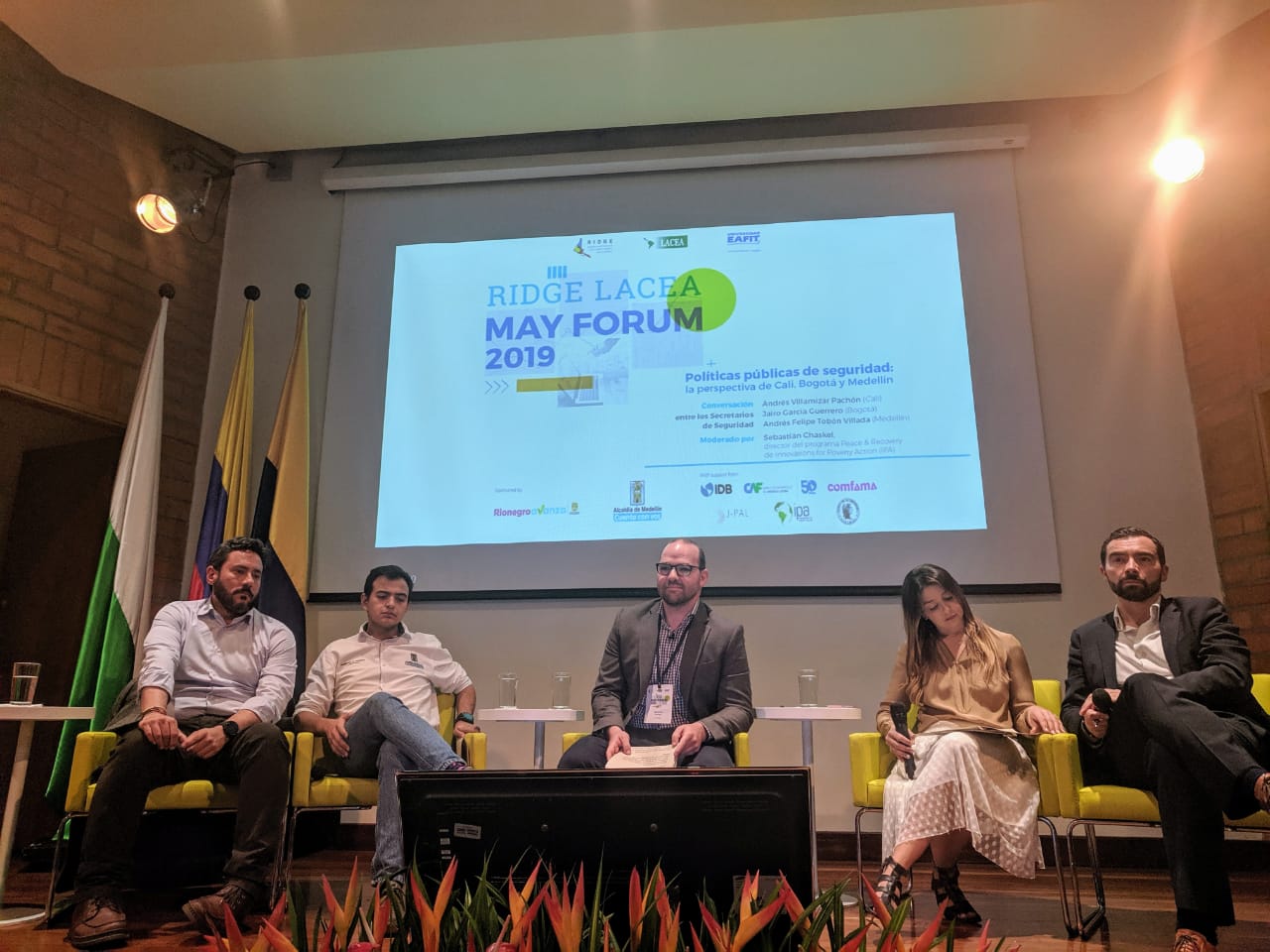Two Takeaways from Our Panel on Security Policy in Latin America

“Our obsession is our citizens’ lives,” said Jairo García, Secretary of Security of Bogotá, at a recent panel I moderated on citizen security policy in Latin America sponsored by IPA’s Peace and Recovery Program and J-PAL’s Crime and Violence Sector at the America Latina Crime and Policy Network (AL CAPONE) annual meeting at EAFIT University in Medellín last month. “But citizens’ obsession is with muggings,” Secretary García went on, as he explained that while Bogotá’s citizens rank security as a top concern, whether they feel safe is more closely related to their perception of the prevalence of muggings rather than homicides.
While the homicide rate in Colombia’s largest cities has dropped drastically in the past 20 years (from the 80-400 per 100,000 range in the 1990s to the 10-50 range today), citizen security continues to rank among the top concerns for the cities’ residents. In response, Colombia’s largest cities created Offices of Security, led by Secretaries of Security, in the past few years. This panel, which brought together the Secretaries of Security of Colombia’s three largest cities—Bogotá, Cali, and Medellín—along with Catalina Gómez Toro, professor of economics at EAFIT, was the first to bring the Secretaries together since their positions were created.
The panel was recorded, is embedded below, and I highly recommend that anyone interested in security policy in the region (and who understands Spanish) watch it. I've also summarized some of the takeaways below.
1. Citizen perceptions of safety are not well correlated with citizen security indicators, yet policy must respond to both. As highlighted in Secretary Garcia’s words above, when citizens in Colombia’s largest cities are asked what they mean when they mention they feel unsafe, they are usually concerned with muggings and theft, and not homicides. Secretary Andrés Villamizar of Cali also mentioned that there is often an inverse correlation between perceptions of safety and the level of crime in a neighborhood—“those that live in the least safe neighborhoods may have been mugged yesterday, but they may feel, I was not shot, I was not stabbed…I therefore do not feel unsafe,” while those that live in safer neighborhoods “may have a lower tolerance for victimizing events.”
Security policy needs to address indicators such as the homicide rate, but must also address perceptions.
Security policy needs to address indicators such as the homicide rate, but must also address perceptions, and this is not only because perceptions of security are determinant to mayors’ approval ratings. Perceptions matter because they determine whether people go outside, whether they know their neighbors, whether they invest in their business, whether they create social fabric, the Secretaries explained, and all this impacts quality of life, which is an end in itself, but also may create a feedback loop—making neighborhoods and cities safer in the medium term.
2. Context matters, and security policy needs to reflect this. The homicide rate per 100,000 citizens today in the three cities (47 in Cali, 24 in Medellín, and 13 in Bogotá) is as different as its underlying causes, and policymaking needs to take this into account. As Secretary Villamizar put it, Medellín is a case of “criminal governance,” where gangs provide services such as justice and conflict resolution, and citizens pay extortion fees as well as request permits from them to conduct business. Meanwhile, Cali is a case of “criminal anarchy,” where gangs exist, but do not control the territory nor have the same control over citizens.
In Medellín, if tension between neighbors rise, neighbors know not to let it escalate. “You need to ask permission to murder someone in Medellin,” Villamizar explained, “which is not the case in Cali.” This helps explain, according to the Secretaries, Medellín’s low murder rate in comparison to Cali. Most of Bogotá, in contrast, does not have a gang presence, except for a few outlier neighborhoods where the homicide rate is high.
"You need to ask permission to murder someone in Medellín."
The types of homicides are also different in nature—in Medellin they are often tied to gang turf wars, while in Bogotá Secretary García describes most homicides there as resulting from “problems related to daily coexistence (convivencia in Spanish),” and Cali seems to be a mix of both—as Secretary Villamizar describes it, “a problem of criminal coexistence” .
When police target gangs in Cali, the Secretaries agreed, the homicide rate tends to go down in those neighborhoods, while when police do the same in Medellín, the homicide rate goes up as gangs reposition themselves. In Bogotá, it varies by neighborhoods.
When police target gangs in Cali...the homicide rate tends to go down in those neighborhoods, while when police do the same in Medellín, the homicide rate goes up as gangs reposition themselves.
The Secretaries all agreed that “criminal governance” cannot be tolerated—that gangs should be combatted, even if they are providing services to the community, and even if, as in the case of Medellín, the short-term homicide rate increases as a result. As Secretary Andrés Tobon of Medellín mentioned, gangs are brought in to resolve problems because citizens find them effective, but “people know the cost of this is the permanent fear they live with every day.”
The panel discussion highlights the need for rigorous, and contextualized, evidence policymakers need to make cities in Latin America and the Caribbean safer. IPA is already partnering with researchers to help fill this evidence gap with a completed research project in Bogotá which found a combined effect of hotspot policing and municipal clean-ups on violent crime. An ongoing study in Medellín builds on hundreds of interviews with police, neighborhood, and gang leaders trying to replace gang governance of neighborhoods with more effective city governance. In Mexico, IPA is working with researchers to improve police responsiveness to citizens. IPA’s Peace and Recovery program hopes to build the evidence base further by funding new research projects on how to tackle violence and homicide in Latin America and the Caribbean.












